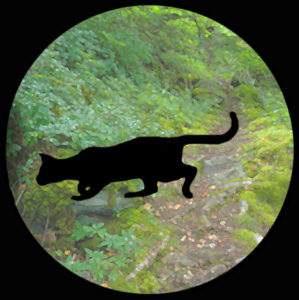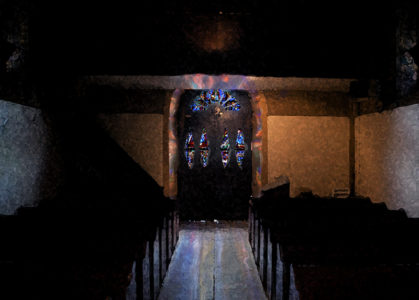I’ve been thinking a lot about how This Madness of the Heart (and all the following Miranda Lamden Mysteries) fit together with my Yeshua’s Cats series–and why I feel certain the two series can coexist as books by the same author. But since my reasons are more feelings and instincts than logic, I’ve had trouble putting them into words.
So I did what I often do when I need to make sense of something: I created a piece of art (below). After all, what good is an art therapy degree if you can’t use it to clarify your own confusion? If I’m lucky, by explaining the image I’ll be opening up what lies behind it!

So, what are you looking at here?
First, I chose a Hubble image for the background: “Interacting Spiral Galaxies” . . . surely ideal for this project, since galaxies don’t often interact–anymore than churchfolk and professor-sleuths! It felt like a propitious beginning.

Three interlocking circles fill the foreground. The center circle pulses with a glowing gold and green light; the Christian Chi Rho emerges from its heart.

What is the Chi Rho? Like most symbols, it has different meanings across cultures, but for me it’s a symbol used by early Christians in the first three centuries after Yeshua’s birth–before Constantine transformed it into an imperial banner (the cross didn’t emerge as a Christian symbol until after the year 500).

The Chi Rho gets its name from the two Greek letters that overlap to create the symbol: Chi and Rho, the first two letters of the Greek word Christos, or Christ. In the image above, the Greek letters Alpha and Omega are added. I did experiment with using a cross in the center circle, but I like the visual effect of the Chi Rho better, probably because it has “rays” like the sunburst. Anyway, the central circle is meant to be the Christian faith–not the organized religion–but the living faith of all the individuals who hold themselves to be Christian.

The circle to the right is Mari, from Yeshua’s Cat, turning aside from a path in a green forest to investigate the central circle. In her circle she represents all of the natural universe. Creation. Everything that exists naturally, apart from the intervention of humankind. This natural order also includes human beings, since they’re part of the created universe–but not their civilizations.
The totality of the created world–as we know it on Earth–is flowing back from Mari’s search like the tail of a comet.

The circle on the left is where Miranda, my detective, lives. Her circle is the world of human civilization–urban, complex, multi-cultural, and often unsure exactly what they believe. Many, like Miranda, have their roots in Christianity, but have turned away from the church. Spinning out from her circle is a spiral of different world religions. But in her circle she, like Mari, has paused to examine something about the Christian faith that has caught her eye.
Both Mari and Miranda live outside the Christian fold, and they approach it from opposite directions. Mari moves from the non-human, natural environment, Miranda from a detached, urban, academic world. Still, both find themselves intrigued by the light in the center circle. Mari has the easier approach: Yeshua introduces himself by saving her life, and she joins him as a friend. But Miranda has been scarred by her Christian experience; she mistrusts the church and its agendas. As a professor, she sees all religions as examples of the human yearning toward the divine. Truth claims don’t enter the picture. She simply records what she observes, without making judgments. Her methods are catlike: she steps cautiously toward anything new, not committing herself, poised to slip back into the shadows if conflict threatens.
I knew a number of women like Miranda in my years apart from the church. Their worlds were full and rich, but they didn’t screen their experiences through a Christian worldview. Yet they were sometimes attracted by a light shining out from this tradition many of them had left behind.
. . . maybe the light shone through a person
a man like Elmus
or as comfort in the midst of evil
perhaps through the One’s presence in some crisis of their own
or simply in prayer and meditation.
But today we live in a world where it’s increasingly difficult to say, “I believe.” The language is lost. What does it mean to believe? Who are we believing in? People who live in the secular world can’t respond to most Christian overtures–because they don’t understand the words anymore. God-talk is becoming literal non-sense to those outside the churches.

People like Miranda are who they are, just as cats are cats. Each responds to life according to their gifts . . . but for some reason those inside and outside the churches are drawing further apart.
Perhaps we might learn from the effort, and love, we put into cross-species communication with our cats (and dogs, gerbils, birds, and ferrets) . . . and look at the incomprehensible human beings around us as if they concealed inner selves as delightful, unique, and full of surprises as a cat’s. It’s not really such a stretch.
I happen to find the lives of alienated Christians intriguing, perhaps because I’ve been there myself. And if the polls are right, their numbers are growing. Their honesty is often fierce, like their determination never to be taken in again by faux-Christianity and self-serving lies. Sadly we don’t have to look far to find the lurking predators they’re avoiding. And that’s what This Madness of the Heart is about.
Miranda peers into the light of Christian faith–but she looks from a place apart. Her own experiences haven’t shown Christianity to be that promised “light to the gentiles.” So she watches, examines, records, and considers. In the meantime, I feel privileged to narrate her journey.




